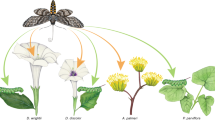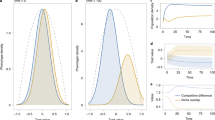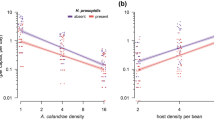Abstract
THE effects of interspecific competitive encounters have traditionally been viewed in terms of species replacement, but recent workers1,2 have recognised the importance of weak or diffuse competition, which leads only to reduced niche volume. Evidence of such niche restriction has been obtained from the study of bird communities, where it has been shown that species often expand niche dimensions in areas with few species2,3. For example, one-third as many bird species are present on the island of Puercos as on the nearby Panamanian mainland and the insular birds forage in a wider range of habitat types than conspecific mainland birds4. Unfortunately this rather direct method of relating changes in niche width to changes in competitive background is often difficult to apply but the importance of competition can be evaluated in other ways. It is generally conceded that if competition occurs at all, it will be strongest among phenotypically similar species5. More explicitly, the intensity of competition which a species faces should be inversely related to its phenotypic isolation, where such isolation is a complex function of the phenotypic distance between a species and coexisting species which share limiting factors.
This is a preview of subscription content, access via your institution
Access options
Subscribe to this journal
Receive 51 print issues and online access
$199.00 per year
only $3.90 per issue
Buy this article
- Purchase on Springer Link
- Instant access to full article PDF
Prices may be subject to local taxes which are calculated during checkout
Similar content being viewed by others
References
MacArthur, R. H., Geographical Ecology (Harper and Row, New York, 1972).
Terborgh, J., Ecology, 52, 23–40 (1970).
Diamond, J. M., Proc. natn. Acad. Sci. U.S.A., 67, 529–536 (1970).
MacArthur, R. H., Diamond, J. M., and Karr, J. R., Ecology, 53, 330–342 (1972).
Rothstein, S. J., Am. Nat., 107, 598–620 (1973).
Hairston, N. G., Smith, F. E., and Slobodkin, L. B., Am. Nat., 94, 421–425 (1960).
Williamson, M., The analysis of biological populations (Edward Arnold, London, 1972).
Harmsen, R., Hebert, P. D. N., and Ward, P. S., J. Res. Lep., 12, 127–134 (1973).
Preston, F. W., Ecology, 29, 254–283 (1948).
Pielou, E. C., An Introduction to Mathematical Ecology (Wiley-Interscience, New York, 1969).
Zwolfer, H., Dynamics of Populations, (edit. by den Boer, P. J., and Gradwell, G. R.) (Oosterbeek, 1970).
Andrewartha, H. G., and Birch, L. C., The Distribution and Abundance of Animals (University of Chicago Press, Chicago, 1954).
Thompson, W. R., Ann. Rev. Ent., 1, 379–402 (1956).
Ehrlich, P. R., and Birch, L. C., Am. Nat., 101, 97–107 (1967).
Author information
Authors and Affiliations
Rights and permissions
About this article
Cite this article
HEBERT, P., WARD, P. & HARMSEN, R. Diffuse competition in Lepidoptera. Nature 252, 389–391 (1974). https://doi.org/10.1038/252389a0
Received:
Revised:
Issue Date:
DOI: https://doi.org/10.1038/252389a0
This article is cited by
-
Some effects of vegetation cover and disturbance on a tropical ant fauna
Insectes Sociaux (1977)
-
Competition and species abundance (reply)
Nature (1975)
-
Competition and species abundance
Nature (1975)
Comments
By submitting a comment you agree to abide by our Terms and Community Guidelines. If you find something abusive or that does not comply with our terms or guidelines please flag it as inappropriate.



